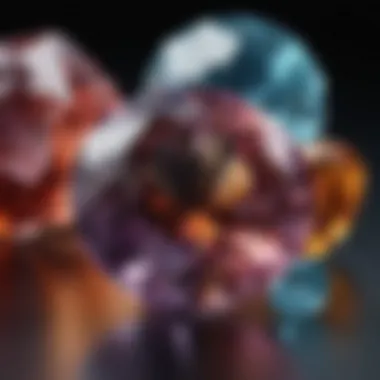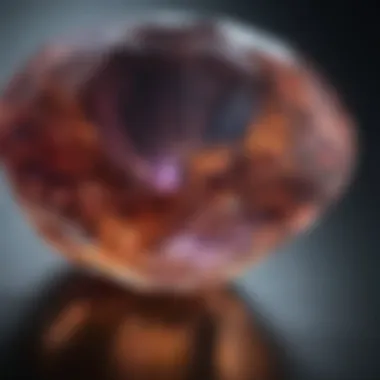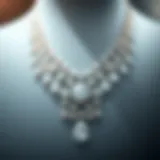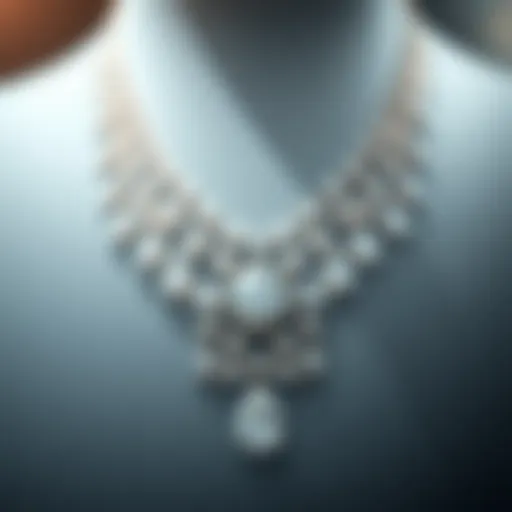Mastering the Art and Science of Gemstone Shaping


Intro
Gemstone shaping is a skill that combines both science and art. The process is essential for transforming rough stones into dazzling pieces of beauty, enhancing their natural characteristics. Understanding this intricate journey from raw material to polished jewel offers valuable insights to enthusiasts and professionals alike. This article aims to provide a detailed exploration of gemstone shaping, emphasizing technique, execution, and artistic value.
Gemstone Overview
Description of the Gemstone
Gemstones are naturally occurring minerals or organic materials valued for their beauty and rarity. Each variety possesses unique colors, clarity, and characteristics, which contribute to its overall appeal. For example, emeralds exhibit a deep green hue, while sapphires can showcase shades ranging from blue to pink. Beyond mere aesthetics, the origin and composition of gemstones impact their desirability significantly.
Physical Properties
Most gemstones share certain physical properties that aid in their classification:
- Hardness: Measured on the Mohs scale, this indicates a gemstone's resistance to scratching. Diamonds, with a rating of 10, are the hardest gems available.
- Refractive Index: This property determines how much light bends as it passes through a gemstone, directly affecting its brilliance and sparkle.
- Specific Gravity: This measurement gauges the density of a gem in comparison to water, helping in identifying different types of stones.
Understanding these properties is crucial, as they inform the techniques artisans use during the shaping process.
Healing Properties
Metaphysical Attributes
Beyond physical characteristics, many gemstones are thought to possess metaphysical healing properties. Amethyst, for instance, is often associated with tranquility and balance, believed to enhance spiritual awareness. Rose quartz is recognized for promoting love and emotional wellness. These attributes attract a diverse audience, including those interested in holistic healing.
Common Uses in Holistic Practices
In the realm of holistic practices, gemstones serve various purposes:
- Gemstone therapy: Practitioners place stones on specific body parts to facilitate energy flow.
- Meditation: Many individuals use gemstones to heighten focus and clarity.
- Jewelry design: Elegant pieces are crafted not only for adornment but also for their perceived healing benefits.
Engaging with gemstones through these practices underscores their multifaceted role in cultures worldwide.
"The journey of a gemstone is a blend of natural beauty and human craftsmanship, reflecting the balance between nature and art."
This exploration sets the stage for understanding the cutting and shaping techniques that help artisans maximize both beauty and value in each gemstone.
Prelims to Gemstone Shaping
Gemstone shaping is an essential component of the gem and jewelry industry. It transforms raw stones into captivating creations that can exhibit brilliance and aesthetic appeal. This process is not merely a technical skill; it intertwines artistry with science. Understanding the significance of gemstone shaping can deepen appreciation for the craft and for the invaluable pieces of jewelry themselves.
The importance of gemstone shaping lies in its ability to enhance the physical and optical characteristics of a stone. A well-shaped gemstone not only highlights its natural beauty but also maximizes its value. This impacts the final product's marketability. For jewelry designers and collectors alike, understanding this aspect can influence purchasing decisions and design choices.
Historical Context
Historically, the art of gemstone shaping dates back thousands of years. Ancient civilizations, such as the Egyptians and Mesopotamians, cultivated techniques that later evolved into modern practices. They crafted gems not only for adornment but also for ritualistic purposes. Over time, as technology advanced, so too did the methods used to shape and polish gemstones. Today, artisans utilize both traditional hand tools and cutting-edge technology, reflecting a rich history of innovation.
In many cultures, specific gemstones became associated with various attributes or powers. This adds depth to their value beyond mere aesthetics. For instance, the vibrant sapphire was highly valued in medieval Europe for its royal connections, while diamonds were coveted for their supposed invincibility. These cultural narratives have remained integral to the appeal of gemstones in modern jewelry making.
Significance in Jewelry Making
In the realm of jewelry making, gemstone shaping plays a pivotal role. The cut and polish of a gemstone can significantly affect its visual impact and perceived value. A well-executed cut not only showcases the stone’s color and internal patterns but also influences how light interacts with the gem. For jewelry designers, the choice of cut can dictate the overall style and personality of a piece. Choosing a brilliant cut may convey elegance, while a cabochon can evoke a more organic and raw feel.
Understanding Gemstone Properties
Understanding gemstone properties is crucial for both artisans involved in the shaping process and for collectors or jewelry designers appreciating the finished product. This section delves into the core aspects that define how gemstones behave, how they can be shaped, and how they influence the overall aesthetics and value of a piece. The two main categories explored here are physical properties and optical properties.
Physical properties refer to the tangible characteristics of gemstones, such as hardness, density, and crystal structure. These properties affect how a gem can be cut without losing its integrity. In contrast, optical properties pertain to how light interacts with the gemstone, which can significantly alter its visual appeal. Understanding these properties empowers artisans to choose the right cutting style, thereby maximizing the beauty and functionality of the stones.
The benefits of comprehending gemstone properties include:
- Enhanced Aesthetic Appeal: A gem that is well-shaped in light of its physical constraints is more likely to dazzle.
- Informed Cutting Decisions: Knowledge of the stone's hardness and structural features helps in the selection of appropriate tools and techniques.
- Value Maintenance: Proper handling and shaping can preserve or enhance a gemstone's market value.
In the following sections, we will dissect both physical and optical properties in detail, revealing their significance in gemstone shaping.
Physical Properties of Gemstones
Physical properties serve as the fundamental characteristics that determine a gemstone's quality and suitability for various types of cuts. One of the most important aspects is hardness, measured by the Mohs scale. For instance, diamonds score a perfect 10, while talc ranks at 1. This scale signifies how resistant a gemstone is to scratches, influencing the choice of cutting techniques.
Other physical properties include:


- Density: This informs the gem cutter about how much material is present, affecting the weight of the final piece.
- Crystal Structure: Different crystal arrangements result in unique cleavage planes, guiding cutters in determining how to slice and shape the stone effectively.
- Cleavage and Fracture: Understanding a gemstone's tendency to split or break along certain planes is vital in planning cuts, as improper techniques could ruin the gem.
These physical attributes ensure that artisans approach each stone with a tailored method, maximizing its potential.
Optical Properties and Their Importance
The optical properties of gemstones can dramatically influence a gem's appearance and market value. These include aspects like refractive index, dispersion, and transparency. Understanding how light passes through and interacts with a gemstone is essential for achieving desirable visual effects.
For instance:
- Refractive Index (RI): This indicates how much light is bent when it enters a gemstone, directly impacting its brilliance. Higher RI often correlates with a more eye-catching sparkle.
- Dispersion: This refers to how effectively a gem can separate white light into its spectral colors. A higher level of dispersion can create what is known as fire in a gemstone, which enhances its visual allure.
- Transparency: This characteristic defines how much light can pass through the stone. Gems with varying transparency levels will require different cutting strategies to highlight their best features.
"Understanding the optical behavior of gemstones is not just for aesthetics; it's fundamental to their valuation in the market."
In summary, mastering gemstone properties lays the groundwork for effective shaping techniques. The interplay between physical and optical elements creates a multi-dimensional understanding of each stone’s capabilities, guiding artisans to achieve optimal results.
Different Styles of Gemstone Cuts
Understanding the various styles of gemstone cuts is crucial for those involved in jewelry making, collecting, and appraisal. Each cut influences not just the aesthetic quality of the gemstone but also its value. Different cuts can highlight the unique properties of the material, allowing the stone to radiate its beauty. Knowledge of these styles is essential for both artisans and buyers.
Brilliant Cut
The brilliant cut is among the most popular styles for diamonds and other gemstones. This cut maximizes the stone's ability to reflect light, creating exceptional brilliance and fire. Comprising numerous facets, typically 57 or 58, the brilliant cut allows for intricate light interaction. This is particularly important in diamonds, where the quality of light reflection can significantly impact the stone's allure and price.
In essence, the brilliant cut is designed to enhance sparkle. This is often the preferred choice for engagement rings due to its timeless appeal. However, the complex nature of this cut requires expert craftsmanship. Any miscalculation in angle or depth can dull the gem’s brilliance.
Step Cut
The step cut, usually associated with emeralds, operates with fewer facets arranged in a linear pattern. This cut showcases the clarity and color of the gemstone, rather than maximizing sparkle. The long, rectangular facets create a hall of mirrors effect, allowing observers to view the stone’s internal features.
Step cuts are less demanding than brilliant cuts, making them more accessible for larger stones. However, they do require high-quality material to ensure visual appeal. A defect in a step-cut stone is often more noticeable due to the clarity focus.
Rose Cut
The rose cut is characterized by a rounded, flat base with a series of triangular facets on top. This style offers a vintage charm, often sought after for unique pieces. Unlike other cuts, the rose cut reflects light primarily from its top rather than its sides, providing a softer glow.
Originally popular in the 16th century, the rose cut is now regaining favor among modern designers. This cut can enhance the color of less brilliant stones, offering a romantic and nostalgic feel. Each rose-cut gemstone carries its individuality, making it a favored choice for bespoke jewelry.
Cabochon Cut
The cabochon cut presents a smooth, rounded dome without facets. This style showcases the stone's natural beauty, often used for opaque stones like opals or turquoise. The cabochon cut emphasizes the color and pattern, bringing attention to the stone's character rather than its brilliance.
This cut is less common in high-value gemstones since it doesn’t emphasize clarity and reflectivity. However, cabochons can hold significant appeal in bohemian and artisanal jewelry fashions. Additionally, the smooth surface makes cabochons durable and suitable for rings or pendants frequently worn.
Emerald Cut
The emerald cut resembles a modified step cut but has a unique rectangle layout with clipped corners. This cut often highlights the color and clarity in gemstones, making it an excellent choice for emeralds and other large stones. The long facets create a staircase effect that can draw the eye and enhance the depth perception of the gem.
Emerald cuts are often synonymous with sophistication. They require high-quality gemstones to avoid visible inclusions. As such, the emerald cut is frequently associated with high-end jewelry pieces, particularly in engagements and statement rings.
"Understanding different styles of gemstone cuts can empower both buyers and artisans to appreciate the craft involved in gemstone shaping deeply."
Overall, recognizing the various cutting techniques is fundamental for gemstone enthusiasts. Each style not only affects a stone's visual appeal but also its perceived value in the marketplace.
Tools and Techniques in Gemstone Shaping
Understanding the tools and techniques involved in gemstone shaping is vital. This area combines the intricate knowledge of gemology with skilled craftsmanship. Proper tools can dramatically influence the outcome of the shaping process. They allow artisans to achieve precision, enhance the aesthetic appeal of gemstones, and maximize their value. Additionally, adapting to new techniques can help increase efficiency and reduce material wastage.
Essential Tools for Gem Cutters
Gem cutters employ a variety of tools in their craft. Each tool serves a specific purpose and contributes to the overall shaping process. Some common tools include:
- Diamond Blades: These are essential for cutting hard stones. They penetrate the gem's surface with minimal risk of chipping.
- Lapidary Saws: These tools allow for larger slices from rough stones, providing material for further shaping.
- Grinders: Used to smooth and shape the gem after the initial cut. This tool can create various facets and edges.
- Polishers: They are crucial for achieving a high shine on the gemstone. A well-polished stone can greatly enhance its visual appeal.
- Calipers: These tools help in measuring the gemstone accurately, ensuring proper proportions during cutting.
Each tool has its specific uses, and knowing when to use them is key to successful gemstone shaping. A skilled artisan can decide which tools to utilize based on the properties of the gemstone being worked with.
Advanced Tools and Technology
In recent years, advancements in technology have introduced new tools that have made gemstone shaping more efficient. Some innovative tools include:


- CNC Machines: These computer-controlled machines can perform intricate cuts that require high precision. They reduce the time needed significantly compared to manual cutting.
- Laser Cutters: These allow for detailed and precise shaping of gemstones. Lasers produce less heat, decreasing the risk of damage to the gem.
- 3D Printing: This technology enables the creation of prototypes for unique designs. It helps in visualizing complex cuts before actual shaping takes place.
- Gemstone Scanners: These devices allow artisans to analyze the internal structure of gemstones. Understanding hidden features can lead to better cutting strategies.
The integration of advanced technology doesn't replace traditional methods but rather complements them. It paves the way for innovations that expand the possibilities in gemstone shaping, making it both an art and a science.
The Process of Shaping Gemstones
The process of shaping gemstones is pivotal in turning raw stones into exquisite pieces suitable for jewelry and collection. It does not only involve cutting but also requires a meticulous understanding of the gemstone’s properties. A well-executed shaping process can enhance the stone's beauty, optimize its brilliance, and increase its overall value. Here, we will explore the critical steps in shaping gemstones: initial assessment, planning the cut, and cutting and polishing.
Initial Assessment
The initial assessment is the first crucial step in shaping gemstones. This stage involves a thorough examination of the rough stone. Artisans look for natural inclusions or imperfections that may affect the final output. Factors such as size, color, and clarity are also taken into account to determine the potential of the gemstone. The initial assessment gives the artisan valuable insights into how to approach the shaping process.
- Inclusions: These are flaws or irregularities within the stone. Some can add character, while others may detract from its value.
- Color: The richness and saturation of color can significantly influence the appeal of the finished stone.
- Size: The dimensions of the rough stone will dictate what shapes can be cut and the final size of the gemstone.
An artisan's ability to accurately assess these aspects directly impacts the outcome and value of the gemstone.
Planning the Cut
Planning the cut is the next step, crucial for achieving the desired results. This stage involves calculating how to maximize the stone’s quality and create a shape that highlights its unique features. Here, artisans use their knowledge of different cutting styles, weighing the potential aesthetic and financial outcomes of each option.
Some considerations during this phase include:
- Cutting Style: The selection of a brilliant cut, step cut, or cabochon will depend on the stone's attributes and desired visual effects.
- Weight Retention: Artisans consider how much of the rough stone can be preserved while achieving the best visual result.
- Symmetry and Proportions: Proper symmetry and proportions are vital for visual appeal and optimal light performance.
The planning phase serves as a blueprint, guiding the artisan throughout the shaping process.
Cutting and Polishing
Cutting and polishing represent the final stages in the shaping process. During cutting, artisans utilize specialized tools to carefully remove material based on the planned design. Precision is crucial here, as any miscalculation can lead to irreversible results.
Once the cutting is completed, polishing follows. This phase aims to enhance the stone's shine and smoothness, making it visually striking. Different grit levels of polishing compounds are used to achieve the required finish.
The polishing aspects involve:
- Polishing Techniques: Various techniques may be employed, such as the use of a lapidary wheel or hand-polishing with abrasives.
- Final Inspection: After polishing, a final evaluation ensures that the gemstone meets the desired standards of quality and aesthetics.
A well-shaped gemstone not only elevates its inherent beauty but also its market value and desirability in the jewelry sector.
Gemstone Shaping and Value
Gemstone shaping plays a vital role in determining both the aesthetic appeal and market value of gemstones. The way a stone is cut and shaped affects its brilliance, color, and overall desirability. The grading of precious stones relies heavily on how expertly they are shaped. The nuances of each cut can enhance or diminish a gemstone's natural properties. Consequently, both collectors and jewelry designers must pay careful attention to the intricacies of gemstone shaping to ensure the highest possible value in their pieces.
Impact on Value and Appeal
The impact of shaping on a gemstone's value cannot be overstated. Different cuts highlight various aspects of a gemstone's physical and optical properties. For instance, a brilliant cut maximizes light reflection, enhancing sparkle and color. This makes the stone more appealing and can significantly increase its market price.
Factors influencing value include:
- Cut Quality: Precision in cutting leads to better symmetry and proportions, resulting in more brilliance.
- Rarity of Shape: Unique cuts such as the cushion cut can fetch a higher price due to their distinctiveness.
- Market Preferences: Trends in gemstone cuts can shift, affecting demand. For example, vintage cuts have regained popularity, influencing their value.
The skilled craftsmanship that goes into shaping is also a determining factor in value. Experienced artisans can create shapes that accentuate the gemstone's beauty, providing a competitive edge in the market.
Market Trends for Cut Gemstones
Market trends for cut gemstones are continually evolving, influenced by fashion, technology, and consumer preferences. Currently, there is a visible shift towards more personalized and unique cuts. Collectors often seek out distinctive shapes that tell a story or represent individual preferences.
Additionally, the rise of online marketplaces has changed how gemstones are bought and sold. The accessibility of information has allowed buyers to become more knowledgeable. They now understand the various cuts and their implications for value.
Notable trends include:
- Sustainable Sourcing: Increasing awareness around ethical sourcing is influencing the popularity of certain cuts that showcase responsibly sourced materials.
- Mixed-Cut Designs: Hybrid cuts combining traditional techniques with modern aesthetics are gaining traction.
- Contemporary Shapes: Non-traditional shapes, such as asymmetrical cuts, are capturing interest for their uniqueness.
"The choices in gemstone shaping are closely linked to current market dynamics, underscoring the interconnected nature of craftsmanship and value."
Cultural and Historical Perspectives
Gemstone shaping is not just a craft; it is an integral part of cultural heritage and human expression. The way gemstones are shaped and valued can reveal much about societal beliefs, artistic styles, and historical contexts. Understanding these cultural and historical perspectives enriches the appreciation of gemstones, adding layers of meaning to each piece.
Gemstones in Different Cultures


Across the globe, gemstones hold significant meanings and roles in various cultures. For instance, in ancient Egypt, gemstones such as lapis lazuli were not only worn as ornaments but were also believed to possess protective powers. The Egyptians carved and polished these stones meticulously, integrating them into their funerary practices, believing they would guide souls to the afterlife.
In contrast, the use of jade in Chinese culture signifies purity and moral integrity. Jade carvings can symbolize status, wealth, and an individual's connection to ancestral heritage.
- Cultural Beliefs: The symbolism attached to gemstones differs dramatically across cultures.
- Religious Significance: In many cases, gemstones appear in religious artifacts, amplifying their sacredness.
- Artistic Expression: Local artisans have historically employed distinct cutting techniques reflecting cultural aesthetics.
"The significance of any gem often transcends its physical form, embedding itself in the fabric of cultural identities."
In modern cultures, gemstones continue to play an important role in celebrations and milestones, such as weddings. Popular choices like diamonds symbolize love and commitment, while other stones, like sapphires, often represent wisdom and royalty. Each stone chosen can reflect personal beliefs and cultural stories.
Evolving Trends Over Time
As societies evolve, so too do the trends in gemstone shaping. What was once determined by tradition and availability of materials has transformed into a fusion of art and science. In the mid-20th century, the popularity of certain gemstone cuts shifted dramatically. The advent of diamond cutting techniques, such as the brilliant cut, revolutionized how these stones were perceived and valued.
- Technological Advances: The introduction of laser cutting and computer-aided design has enabled unprecedented precision in gemstone shaping.
- Consumer Preferences: Nowadays, there is a noticeable trend toward ethical sourcing and sustainable practices emphasizing environmental responsibility.
- Artistic Exploration: Modern jewelers are experimenting with unconventional shapes and mixed materials, challenging traditional boundaries of gemstone craftsmanship.
As tastes change and new materials become available, the art of gemstone shaping continues to evolve. This evolution reflects not only aesthetic preferences but also shifts in societal values and ethical considerations, making the study of gemstones and their shaping a fascinating subject.
Challenges in Gemstone Shaping
Gemstone shaping is an art as well as a science, and it is not without its challenges. These challenges can significantly affect the final product, influencing not only the quality of the gemstones but also the overall aesthetic and market value. Understanding these challenges is key for artisans, collectors, and jewelry designers alike. It allows for better decision-making and enhances appreciation of the skills involved in this craft.
Material Limitations
The first major challenge in gemstone shaping comes from the materials themselves. Each type of gemstone has distinct physical and optical properties that can complicate the shaping process. For instance, softer gemstones like opal can be more prone to scratches and nicks, requiring extra care during cutting. In contrast, harder stones like diamond can be exceptionally tough to cut, necessitating specialized tools and techniques.
Moreover, inclusions and natural blemishes can also present significant hurdles. These imperfections may be, at times, unavoidable when working with certain gemstones. An artisan must carefully evaluate the stone's characteristics before proceeding with shaping. The effectiveness of the process will often hinge on how well an artisan can work around these limitations. Knowing the material is thus crucial to achieving a desirable outcome.
Skill and Experience of the Artisan
Another formidable challenge in gemstone shaping is the skill and experience required by the artisan. The proficiency level of the person shaping the gemstone can influence the quality of the cut and polish significantly. Experienced artisans can intuitively understand how to optimize every cut to enhance light performance, beauty, and durability.
Training and practice are essential. New artisans may struggle, leading to potential errors that can irreparably damage the gemstone. A lack of experience might cause miscalculations during the cutting phase, which can result in a loss of material or worse—an unattractive final product.
Artisans need to grasp both traditional techniques and modern technologies to navigate these challenges effectively. Continuous education and adaptability are vital in this fast-evolving field.
Gemstone shaping is not merely about cutting; it is a nuanced dance between the material's characteristics and the artisan's skills.
Future of Gemstone Shaping
The future of gemstone shaping holds tremendous significance within the broader context of jewelry making and collection. As technology evolves, the field of gemstone cutting and shaping is also experiencing transformative shifts. These advancements are not merely superficial but suggest profound changes in quality, efficiency, and sustainability of gemstone production.
Innovations in Technology
Innovation in technology plays a crucial role in the evolution of gemstone shaping. Cutting-edge tools and machinery are now available, enabling artisans to achieve precise cuts and intricate designs that were previously impossible. Computer numerical control (CNC) machines are becoming increasingly common. These machines enable an unprecedented level of accuracy in shaping gemstones, ensuring more consistent results.
Laser technology is another significant advancement. With lasers, artisans can execute intricate patterns and cuts, while also minimizing waste. Such precision not only improves the aesthetic appeal of the gemstones but can also influence their market value and desirability among collectors.
Furthermore, advancements in digital software allow gem cutters to visualize the final product before beginning the physical shaping process. Programs that use augmented reality enable artisans to design virtually, sharpening their focus on the outcome and making adjustments as needed.
Sustainability Considerations
Sustainability in gemstone shaping has garnered increasing attention, especially in light of global environmental concerns. Consumers are more aware of the impact their purchases have on the planet, and this trend has led to a demand for ethical sourcing and environmentally friendly practices in gemstone shaping.
One way the industry is responding is through the use of sustainable materials. Alternative sources for gems, such as lab-grown diamonds or recycled gemstones, are gaining traction. They offer both reduced environmental impact and ethical considerations without compromising beauty or quality.
Moreover, responsible mining practices are becoming a priority. Businesses are increasingly adopting practices that minimize environmental damage, such as reducing water usage and engaging in land restoration projects.
Culmination
In concluding this exploration of gemstone shaping, it is essential to reflect on its multifaceted importance. Understanding the art and science involved not only enhances appreciation for these natural wonders but also informs collectors and jewelry designers about their choices. The shaping of gemstones is not merely aesthetic; it imparts value and cultivates a connection between the maker and the material. Each cut and polish resonates with the traditions honed over centuries, aligning craft with aesthetic appeal.
Summarizing Key Insights
The process of gemstone shaping is a complex interplay of artistry and science. Key insights from this discussion include:
- Significance of Cut: The gemstone's cut affects its brilliance and overall appeal. Different styles, such as brilliant and cabochon, offer distinct qualities that cater to diverse tastes.
- Tools and Techniques: The advancement of tools, ranging from traditional hand tools to modern technology, has transformed the way artisans approach shaping. This evolution enhances precision and efficiency.
- Cultural Context: Gemstones resonate differently in various cultures, influencing design choices and popularity in jewelry making.
- Market Implications: Trends in gemstone shaping directly impact market value. Awareness of these can aid collectors and designers in making informed decisions.
Encouragement for Exploration
As this article reveals, the field of gemstone shaping is rich and diverse. For enthusiasts and professionals alike, there exists a vast world waiting to be discovered. Researching different types of cuts can lead to a deeper understanding of what makes each stone unique. Engaging with artisan communities or attending workshops will provide firsthand experience of shaping techniques.
Furthermore, the exploration does not stop at the surface. Investigating the geological origins and unique characteristics of each gemstone can enrich one's perspective and appreciation for these treasures.
Ultimately, embracing the journey into gemstone shaping can lead to a more profound engagement with both the material and the inherent artistry involved.
"Knowledge is not only a tool for personal growth but also a bridge connecting us to the rich histories and cultures that gemstones embody."
As you move forward, it is encouraged to delve deeper into this fascinating subject and uncover the stories and techniques that make gemstone shaping an enduring art form.







